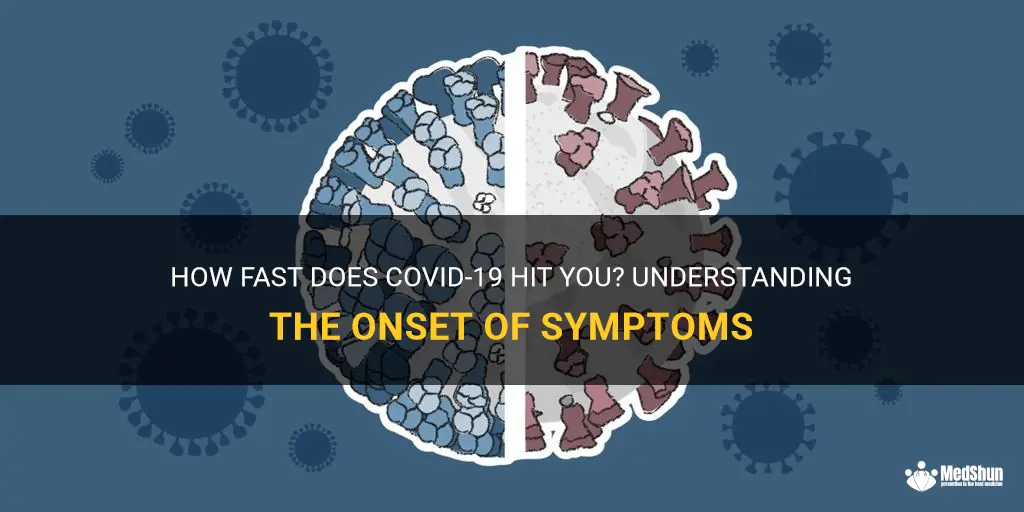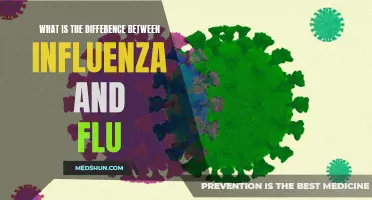
We all remember the day when news of the COVID-19 pandemic first broke out, and little did we know how drastically it would impact our lives. The virus spreads rapidly, affecting millions of people worldwide and causing a wide range of symptoms. From mild coughs and fevers to severe respiratory distress, COVID-19 can hit individuals in various ways. In this article, we will explore the question, Does COVID hit you fast? and delve into the different ways this virus can strike. So, fasten your seatbelts as we embark on an enlightening journey into the unpredictable nature of COVID-19.
| Characteristics | Values |
|---|---|
| Incubation period | 2-14 days |
| Symptoms onset | Typically within a week |
| Severity of symptoms | Varies, from mild to severe |
| Common symptoms | Fever, cough, difficulty breathing |
| Other symptoms | Fatigue, body aches, sore throat, loss of taste or smell |
| High-risk groups | Elderly, those with underlying health conditions |
| Transmission | Person-to-person through respiratory droplets |
| Testing | PCR test |
| Prevention | Vaccination, wearing masks, social distancing, hand hygiene |
What You'll Learn
- How quickly does COVID-19 symptoms appear after exposure?
- Is it possible for COVID-19 to hit you suddenly without any warning signs?
- Are there any early signs or symptoms that indicate a fast onset of COVID-19?
- Is the speed at which COVID-19 affects individuals consistent or does it vary from person to person?
- What are the factors that determine whether COVID-19 symptoms develop rapidly or gradually in an individual?

How quickly does COVID-19 symptoms appear after exposure?
COVID-19, caused by the novel coronavirus SARS-CoV-2, has been spreading rapidly around the world. One of the key questions people have is how quickly symptoms appear after exposure to the virus. Understanding the timeline of symptom onset is crucial for effective contact tracing and early identification of cases.
Research has shown that the incubation period - the time between exposure to the virus and the development of symptoms - for COVID-19 is typically 5 to 6 days. However, it can vary from as short as 2 days to as long as 14 days. This means that most people who are infected with the virus will start showing symptoms within a week of exposure.
It is important to note that some individuals may remain asymptomatic throughout the course of the infection, meaning they do not develop any noticeable symptoms. However, even asymptomatic individuals can transmit the virus to others, which is why widespread testing and contact tracing are crucial in controlling the spread of the virus.
The most common symptoms of COVID-19 include fever, cough, and difficulty breathing. Other symptoms can include sore throat, muscle aches, fatigue, and loss of taste or smell. It is worth mentioning that these symptoms can vary from person to person, and some individuals may experience mild symptoms while others may develop severe illness requiring hospitalization.
The onset of symptoms usually begins with mild symptoms such as a slight fever or a mild cough. Over the course of a few days, the symptoms may progress and become more severe. It is important to monitor your symptoms closely and seek medical attention if you experience any difficulty breathing or if your symptoms worsen.
In some cases, individuals may develop a severe form of the illness known as COVID-19 pneumonia, which can cause acute respiratory distress and require hospitalization. It is crucial to seek medical help immediately if you experience any severe symptoms or if you have any underlying health conditions that put you at higher risk for complications.
To prevent the spread of COVID-19, it is important to practice good hygiene, such as washing your hands frequently, wearing a mask in public spaces, and maintaining physical distance from others. Additionally, it is recommended to get vaccinated against COVID-19 to protect yourself and others from the virus.
In conclusion, the timeline for developing symptoms after exposure to COVID-19 can vary, but most people will start showing symptoms within 5 to 6 days. It is important to monitor your symptoms closely and seek medical attention if necessary. By following preventive measures and getting vaccinated, we can reduce the transmission of the virus and protect ourselves and our communities.
Understanding Allergies: Can You Spread Them to Others?
You may want to see also

Is it possible for COVID-19 to hit you suddenly without any warning signs?
COVID-19, the respiratory illness caused by the novel coronavirus SARS-CoV-2, has taken the world by storm since it was first identified in late 2019. The virus has led to mass outbreaks, overwhelmed healthcare systems, and caused thousands of deaths worldwide. With such devastating consequences, it is natural for individuals to wonder whether they can be struck by COVID-19 suddenly, without any warning signs.
According to scientific research, it is unlikely for COVID-19 to hit someone suddenly without any prior warning signs. The majority of infected individuals experience some symptoms before their condition worsens. The most common symptoms include fever, cough, shortness of breath, loss of taste or smell, fatigue, body aches, sore throat, and headaches. These symptoms usually appear between 2 to 14 days after exposure to the virus.
Experience and anecdotal evidence also support the notion that COVID-19 does not typically strike suddenly without any warning signs. Numerous individuals who have contracted the virus have reported experiencing mild symptoms such as fatigue or a mild cough for a few days before their condition worsened. Some individuals even experienced symptoms for several weeks before being diagnosed with COVID-19. This suggests that the virus generally follows a predictable progression, giving individuals some time to recognize and seek medical attention if necessary.
It is important to note that not everyone infected with COVID-19 experiences symptoms. Asymptomatic cases, where individuals do not show any signs of illness, are not uncommon. However, even in these cases, the virus is not hitting suddenly without any warning signs. Instead, individuals are simply not exhibiting any symptoms. These asymptomatic individuals can still transmit the virus to others, making it crucial to follow public health measures such as wearing masks, practicing good hand hygiene, and maintaining social distance.
To further understand the progression of COVID-19, let's take a closer look at the step-by-step process of the disease. The virus primarily enters the body through respiratory droplets when an infected person coughs, sneezes, talks, or breathes. Once inside the body, the virus targets cells in the respiratory system, specifically the ACE2 receptors found in the airways and lungs.
After the initial infection, the virus undergoes an incubation period where it replicates within the body. During this time, individuals may not experience any symptoms but can still transmit the virus to others. As the virus continues to replicate, it causes damage to the respiratory system, leading to the onset of symptoms.
The severity of symptoms can vary widely from person to person. In some cases, individuals may experience mild symptoms that resolve on their own, while in others, the virus can progress rapidly, causing severe respiratory distress and organ failure. Factors such as age, underlying health conditions, and immune response play a significant role in determining the severity of COVID-19 symptoms.
In conclusion, it is highly unlikely for COVID-19 to hit someone suddenly without any warning signs. Scientific evidence, experience, and step-by-step understanding of the disease all indicate that individuals typically experience symptoms before their condition worsens. Recognizing these symptoms and seeking medical attention promptly is crucial in preventing the spread of the virus and ensuring timely treatment for those who need it. By staying vigilant and following public health measures, we can collectively combat the spread of COVID-19 and protect ourselves and those around us.
How Long Do Colds Remain Contagious?
You may want to see also

Are there any early signs or symptoms that indicate a fast onset of COVID-19?
COVID-19, caused by the novel coronavirus (SARS-CoV-2), has a wide range of symptoms that can vary greatly among individuals. While some people may experience only mild symptoms or none at all, others may develop severe respiratory distress or even die from complications of the disease. It is therefore crucial to identify any early signs or symptoms that may indicate a fast onset of COVID-19.
One of the most common early symptoms of COVID-19 is fever. Many individuals who have contracted the virus develop a high temperature within a few days of exposure. This fever may come on suddenly and be accompanied by chills or sweating. It is important to note that not everyone with COVID-19 will develop a fever, so the absence of this symptom does not rule out the possibility of infection.
Another early sign of COVID-19 is a persistent cough. This cough may be dry or accompanied by phlegm. It is often described as a "COVID cough" and may persist for several weeks. If you develop a cough that is different from your usual cough or if it is accompanied by other symptoms such as fever or shortness of breath, it is important to seek medical attention.
Shortness of breath is another early symptom that may indicate a fast onset of COVID-19. This can range from mild difficulty breathing to severe respiratory distress. If you experience sudden or worsening shortness of breath, it is important to seek immediate medical attention, as this could be a sign of a serious respiratory infection.
Other early symptoms of COVID-19 may include fatigue, muscle or body aches, sore throat, and loss of taste or smell. It is important to note that these symptoms can also be caused by other illnesses, so it is important to consider the context of your symptoms and any potential exposures to the virus.
If you experience any of these early signs or symptoms of COVID-19, it is important to take appropriate precautions to prevent the spread of the virus to others. This includes staying home, avoiding close contact with others, and wearing a mask when in public. It is also important to seek medical attention for evaluation and testing.
In some cases, the onset of COVID-19 can be rapid and severe. This is more likely in individuals who are older, have pre-existing medical conditions, or have compromised immune systems. However, it is important to remember that anyone can become seriously ill from COVID-19, regardless of age or underlying health conditions.
In conclusion, while there are no definitive early signs or symptoms that indicate a fast onset of COVID-19, fever, cough, shortness of breath, and other flu-like symptoms can be indicative of infection. It is important to be vigilant and seek medical attention if you experience any of these symptoms, especially if they worsen or if you have been in close contact with someone who has tested positive for the virus. By taking early action, you can help prevent the spread of COVID-19 and protect yourself and others from severe illness.
The Persistence of Cold Virus on Objects: How Long Does it Last?
You may want to see also

Is the speed at which COVID-19 affects individuals consistent or does it vary from person to person?
The speed at which COVID-19 affects individuals can vary significantly from person to person. While some people may experience mild symptoms that resolve within a week, others may develop severe symptoms that require hospitalization and can lead to long-term complications or even death. Understanding these variations in disease progression is crucial for effective control and management of the pandemic.
One of the main factors contributing to the variability in COVID-19 symptom progression is the individual’s immune response. The immune system is responsible for fighting off the virus and clearing the infection. Some individuals have a robust immune response, which enables them to quickly control the virus and recover without severe complications. On the other hand, individuals with a weakened immune system may struggle to mount an effective immune response, leading to prolonged illness and increased susceptibility to complications.
Age and underlying health conditions also play a significant role in the speed at which COVID-19 affects individuals. Older adults and individuals with chronic health conditions such as diabetes, heart disease, or respiratory conditions are at a higher risk of developing severe symptoms and experiencing a more rapid disease progression. These individuals often have weaker immune systems and are more vulnerable to complications.
Additionally, viral load, or the amount of virus a person is exposed to, can influence the speed at which COVID-19 affects individuals. Higher viral loads at the time of exposure may lead to a more rapid onset of symptoms and a faster disease progression. It is important to note that viral load can vary among individuals and is influenced by factors such as close contact with an infected person, duration of exposure, and the effectiveness of preventive measures such as mask-wearing and social distancing.
Furthermore, individual behaviors and adherence to preventive measures have a direct impact on the speed at which COVID-19 affects individuals. By following public health guidelines such as hand hygiene, mask-wearing, and social distancing, individuals can reduce their risk of exposure and slow down the disease progression. Conversely, neglecting these measures can result in a faster spread of the virus and an increased likelihood of severe disease.
To illustrate the variability in COVID-19 symptom progression, let's consider two hypothetical individuals: Person A and Person B. Person A is a young, healthy individual who maintains a healthy lifestyle, follows preventive measures diligently, and has a robust immune system. If Person A were to contract COVID-19, they might experience mild symptoms, such as a low-grade fever and fatigue, which resolve within a week or two with no complications.
On the other hand, Person B is an older adult with pre-existing health conditions, such as diabetes and obesity. Person B may have a weakened immune system and be at a higher risk of severe disease. If Person B were to contract COVID-19, they may experience rapid disease progression, requiring hospitalization and potentially ventilator support. The recovery period for Person B may be longer, and they may also face long-term complications such as lung damage or cardiovascular issues.
In conclusion, the speed at which COVID-19 affects individuals varies from person to person. Factors such as immune response, age, underlying health conditions, viral load, and individual behaviors all contribute to the variability in disease progression. It is crucial to understand these variations to tailor public health strategies and interventions accordingly. By adopting preventive measures and promoting overall health, individuals can minimize their risk of severe illness and contribute to controlling the spread of the virus.
The Latest Virus Making Rounds in Connecticut
You may want to see also

What are the factors that determine whether COVID-19 symptoms develop rapidly or gradually in an individual?
COVID-19, caused by the novel coronavirus SARS-CoV-2, has affected people in various ways. While some individuals exhibit rapid symptom development after contracting the virus, others experience a more gradual progression. Several factors play a role in determining the speed at which COVID-19 symptoms manifest in an individual. These factors include the viral load, immune response, underlying health conditions, and age.
Firstly, the viral load, or the amount of virus present in an individual's body, can influence the speed of symptom development. A higher viral load typically leads to a more rapid onset of symptoms. Viral load can vary depending on the circumstances of exposure. For instance, if an individual has close contact with an infected person for an extended period, they are likely to have a higher viral load, resulting in quicker symptom development.
Secondly, the immune response plays a crucial role in determining the speed of symptom development. When the body is exposed to the SARS-CoV-2 virus, the immune system mounts a defense by producing antibodies and activating immune cells. The effectiveness and efficiency of this response can vary between individuals. Those with a strong immune response may experience a slower progression of symptoms, as the immune cells are more effective at containing the virus and preventing its rapid replication.
Furthermore, underlying health conditions can impact the speed at which COVID-19 symptoms develop. Individuals with pre-existing health conditions, such as diabetes, cardiovascular disease, or respiratory conditions, may experience a more rapid progression of symptoms due to their compromised immune systems and weaker overall health. These conditions can make it more challenging for the body to fight off the virus, leading to faster symptom development.
Lastly, age is a significant factor in determining the speed of symptom development. Older adults, particularly those over the age of 65, are more vulnerable to developing severe symptoms and experiencing a rapid progression of the disease. This is because the immune system weakens with age, making it less effective at combating the virus. Additionally, older adults often have more underlying health conditions, further exacerbating the risk and speed of symptom development.
It is important to note that while these factors can influence the speed at which COVID-19 symptoms develop, they do not guarantee a particular outcome for every individual. Each person's response to the virus is unique, and there can be variations even among individuals with similar characteristics. Furthermore, as research continues, new factors may be discovered that contribute to the speed of symptom development.
In conclusion, the speed at which COVID-19 symptoms develop in an individual can be influenced by several factors, including viral load, immune response, underlying health conditions, and age. While a higher viral load, weaker immune response, presence of underlying health conditions, and older age can lead to a quicker progression of symptoms, it is essential to recognize that each person's experience with the virus is different. By understanding these factors, healthcare professionals can better assess and manage the progression of COVID-19 in affected individuals.
Understanding the Link between RSV and Vomiting/Diarrhea: What You Need to Know
You may want to see also
Frequently asked questions
COVID-19 symptoms can vary from person to person. For some individuals, symptoms may appear suddenly and develop rapidly, while others may experience a more gradual onset of symptoms. It is not uncommon for individuals to become symptomatic within a few days of being exposed to the virus, but it can take up to two weeks for symptoms to present themselves.
According to the Centers for Disease Control and Prevention (CDC), the average incubation period for COVID-19 is around 5-6 days, but it can range from 2-14 days. This means that symptoms can appear as soon as 2 days after exposure to the virus, but it is more common for symptoms to develop within a week of being infected.
While COVID-19 symptoms can vary, there are some early warning signs to watch out for. These can include fever, cough, shortness of breath, fatigue, muscle or body aches, headache, sore throat, loss of taste or smell, congestion or runny nose, nausea or vomiting, and diarrhea. It is important to note that not everyone with COVID-19 will experience symptoms, and some individuals may only experience mild symptoms.







